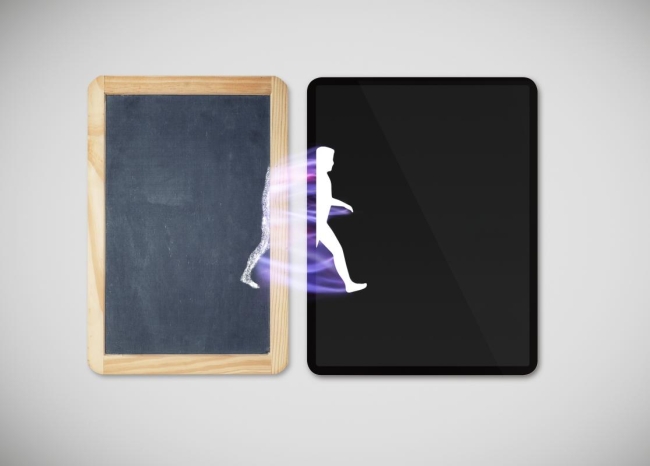You have /5 articles left.
Sign up for a free account or log in.

Istockphoto.com/martinwimmer
Welcome to "Transforming Teaching and Learning," a column that explores how colleges and professors are reimagining how they teach and how students learn. If you'd like to receive the free "Transforming Teaching and Learning" newsletter, please sign up here.
***
What a difference a week makes.
Seven days ago in this space, I went out of my way to say that I hoped to make this column a "coronavirus-free space" to the extent possible, given Inside Higher Ed's excellent coverage of the pandemic elsewhere and the "recognition that the rest of what we all do professionally each day isn’t stopping."
That all may still be true, but the new reality is that COVID-19 is increasingly dominating not just our collective head spaces (in ways helpful and not) but also what our jobs are day to day. That's especially the case in certain realms, including for those of you responsible for helping to deliver instruction and learning at your institutions.
So today, at least -- next week seems very far away at this point -- this column will focus on a question that is generating a good bit of discussion among thoughtful observers of teaching and learning issues: What impact will this sudden, forced immersion and experimentation with technology-enabled forms of learning have on the status of online learning in higher education? Below, 11 experts share their thoughts on how the explosion of remote learning -- much of which may be primitive and of dubious quality -- could affect attitudes and impressions of a mode of learning that already struggles to gain widespread faculty and student support.
***
The prospect of hundreds of thousands of professors and students venturing into academic cyberspace for the first time has prompted some commentators to take to social media to predict that this period could alter the landscape long term for online education. "Every faculty member is going to be delivering education online. Every student is going to be receiving education online. And the resistance to online education is going to go away as a practical matter," James N. Bradley, chief information officer at Texas's Trinity University, wrote in a LinkedIn post.
Goldie Blumenstyk, my friend and former colleague at The Chronicle of Higher Education, went so far as to suggest that the coronavirus could be a "black swan" moment -- "more of a catalyst for online education and other ed-tech tools than decades of punditry and self-serving corporate exhortations." She continued, "It seems safe to say that this will be not only enormously disruptive but also paradigm changing. The 'black swan,' that unforeseen event that changes everything, is upon us."
That's surely possible -- but a very different outcome seems at least as likely. Surely some of the professors who will be venturing into virtual education for the first time because of COVID-19 will be going online with the sort of high-quality immersive courses that the best online learning providers offer. But much of the remote instruction that many professors experimenting outside the physical classroom for the first time will be offering to their students will be nothing more than videoconferenced lectures supplemented by emailed assessments.
That raises tons of issues, from how instructors and colleges treat student grades to how institutions treat student evaluations of professors. But in today's column a collection of sharp and thoughtful analysts answer a more fundamental question: Will forced exposure to and experimentation with various forms of technology-enabled learning lead professors and students to view online education more favorably -- or less so?
The full prompt, and the answers from our experts, follow.
In short order, hundreds of colleges have announced in the last week that because of health concerns related to COVID-19, they are ending in-person classes and moving all instruction to virtual settings. They’re using different language around this -- some are specifically talking about shifting to online education, while others talk about remote classes and the like. Many of them are taking advantage of (and in some cases extending) spring breaks and other cessations of coursework to prepare for the shift, and it will be some time before we can really tell what forms of learning the institutions will adopt during this period.
Several commentators have hypothesized that this time of emergency adoption and experimentation will speed up the adoption and embrace of online and other forms of technology-enabled learning. That is one scenario. Another is that the way colleges and universities transform all of their instruction in this compressed time frame will be a pale imitation of what the best in today’s online learning looks like, and that exposing entire faculties and student bodies to this flawed product will set back, rather than advance, faculty and student attitudes about the quality of technology-enabled learning.
The question/questions I’d ask you to address: What impact do you think this emergency immersion into online/distance learning by many/most institutions might have on faculty and student confidence in technology-enabled learning? Do you believe the end result (recognizing that it may be some time before we can judge) will be more professors believing in the quality of online learning and wanting to incorporate the best of what it can do into their teaching, a blurring of the distinction between online and in-person and a closing of the perceived quality gap? Do you think it could produce greater skepticism about the efficacy of technology-enabled learning, either because the experience for instructors and students alike will be substandard, or because institutions will not sufficiently prepare their instructors to teach in these new ways? Or do you envision some other outcome?
And lastly: What can institutions and individual instructors can do to ensure a better rather than worse outcome?
***
 Deb Adair, executive director, Quality Matters
Deb Adair, executive director, Quality Matters
Our community is at the epicenter of the current emergency remote-teaching disruption. Charged with developing the plan to move teaching immediately online and/or directly making it happen, they are exhausted because their resources fall far short of need. They are also exhilarated because it’s their expertise that makes this pivot possible. Administrators must acknowledge the expertise of their own online units (if they exist) and support them such that a personally overwhelming time doesn’t also become a professional crisis. Leadership will make all the difference.
The campus units supporting online education are often underresourced in the best of times, lacking the institutional investment needed to achieve quality online education at scale. The COVID-19 response makes this worse, not better. Instructional designers and online faculty are professionals stepping up in a moment that highlights the expertise they bring, knowing that it is their time, energy and talent that can make all the difference for their students. If we allow these professionals to leverage their expertise, we can pull off something that is quite incredible -- enabling students to continue their education such that this pandemic does not derail their future plans in the same way it’s limiting their present.
Nobody thinks this is the way online education should be done. Victory during the pandemic will not include the development of high-quality online education. Victory looks like this:
- The creation and execution of suggestions (typically) or plans (aspirational) for both remote teaching/learning and working remotely. It’s tough to be planful when your house is on fire.
- Guidance for faculty to help them translate their teaching expertise into a different learning modality. Institutions that have invested in faculty training for online teaching/design, development of course templates and/or web-enhanced courses will be in a much better position.
- Curated tools, just-in-time training, job aids, course templates, real-time advice are all things an online unit can provide.
- Helping faculty support their students through a difficult time -- focusing on engagement, compassion and flexibility.
Instructional designers and online faculty are professionals stepping up in a moment that highlights the expertise they bring, knowing that it is their time, energy and talent that can make all the difference for their students. If we allow these professionals to leverage their expertise, we can pull off something that is quite incredible -- enabling students to continue their education such that this pandemic does not derail their future plans in the same way it’s limiting their present.
Leadership is critical:
- Recognize the professional burden placed on faculty and staff during a personally stressful time. Encourage them and ask what they need.
- Set realistic expectations.
- Provide guidance about working remotely, including communication tools/protocols, and guard against cyberattacks.
- Ask your online team to vet solutions from external contractors.
- After the emergency, reform policy and procedure to support education online including its importance in instructional continuity.
Any suggestion that this is the time to evaluate the efficacy of online education is more than absurd. It’s ignorant at best and disingenuous at worst. Shelve the debates about the role of faculty and of online education. Focus on problem solving now, not the future of higher education. We’ll get back to that soon enough.
***
 Kelvin Bentley, vice president of learning strategy, Six Red Marbles
Kelvin Bentley, vice president of learning strategy, Six Red Marbles
It has been interesting reading about the many colleges and universities that have decided to shift on-campus instruction to a remote teaching model. There are on-campus faculty who are not the best teachers, and this fact will be more salient as such faculty are required to use technology quickly to meet their respective institutions’ decisions to use technology-enhanced teaching as a form of social distancing.
There is always a chance that some faculty who have been resistant to using technology to facilitate their teaching will be more likely to embrace their newer teaching practices over time. This will be a more likely outcome if colleges and universities are vigilant in helping faculty learn about and actively use the instructional technology tools available to help students be successful in their courses. It will be important for institutions to encourage students to share their feedback weekly about the learning experiences their instructors are shaping for them using technology. When faculty can put their teaching egos aside and use negative student feedback to improve their remote teaching practices, students will benefit and hopefully faculty will, too, because they will learn how best to meet the learning needs of their students.
There is always a chance that some faculty who have been resistant to using technology to facilitate their teaching will be more likely to embrace their newer teaching practices over time. This will be a more likely outcome if colleges and universities are vigilant in helping faculty learn about and actively use the instructional technology tools available to help.
Besides faculty adapting their style of teaching, institutions will need to have clear plans about how they will provide certain services to students. Such services include advising, proctoring, tutoring. Fully online versions of such services might exist to support current online students, but institutions will have to ensure that all students have access. This can be challenging to achieve, given some online services such as proctoring and tutoring are based upon actual student use, which can overwhelm some school budgets that are not already inclusive of such services across all students.
It will be important for institutions to carefully evaluate their remote teaching strategies across all courses after the COVID-19 crisis subsides. Institutions will need to use postmortem feedback from both their students and faculty to improve their contingency plans and how they prepare students and faculty to engage in remote learning and teaching, respectively, when institutions have to close due to a crisis. It will also be important for institutions to update their existing plans yearly and discuss how such plans can be improved upon based upon available research on how best to use technology to positively impact student learning.
***
 Jody Greene, associate vice provost for teaching and learning, dean, Center for Innovations in Teaching and Learning, and professor of literature, University of California, Santa Cruz
Jody Greene, associate vice provost for teaching and learning, dean, Center for Innovations in Teaching and Learning, and professor of literature, University of California, Santa Cruz
Instructors in higher education settings have been practicing social distancing and self-isolation since universities were founded in the Middle Ages. One of the most remarkable dimensions of this moment is that even as we move en masse to teach remotely, we are also for the first time beginning to move en masse to thinking about teaching collectively.
Anyone even minimally involved in teaching or supporting teaching at a college or university has over the past week witnessed a quiet revolution (though one with many keystrokes), in which instructors have turned to teaching centers and instructional design units, as well as to colleagues, professional organizations, social media and internet search engines, to learn together about a range of digital tools they will need to use to teach remotely and about the design consequences of those choices. Teaching center staff who have been shouting into the wind about the benefits of learning communities can’t help but smile as the entire collegiate instructional workforce scrambles to find the nearest Hangout or Zoom teaching happy hour.
Once these tools have been identified and selected, each is going to require some wildly creative pedagogy to be genuinely useful for instruction. Since we are not designing courses from scratch to be taken fully online with self-paced learning, we are unlikely to learn much of use from this exercise about the pros or the cons of online education. However, we will learn a great deal about hybrid modes of instruction and about ways to make selective practices, such as prerecorded lectures or message board-style discussions, effective tools for learning. At the end of the day, those of us who have hesitated to use any technological tools in our teaching because the learning curve feels too steep will have been forced to consider and actively engage with a range of digital options (from lecture capture to peer editing in Google Docs) and practices (from flexible attendance policies to contract grading) that have been touted by proponents of universal design and considered off the table by many instructors until now.
If I had to put money on the single genuinely revolutionary effect of the Great Remote Learning Hack of 2020, it would be the fact that instructors finally understand that teaching is something they can engage in as a collective activity, an activity that is more pleasurable and much more intellectually interesting when we participate in it in the company of others.
I suspect that being forced to get “over the bar” of minimally technologically enhanced and maximally flexible course design and policies will mean that many of us are more inclined to use these tools and practices in the future.
But if I had to put money on the single genuinely revolutionary effect of the Great Remote Learning Hack of 2020, it would be the fact that instructors finally understand that teaching is something they can engage in as a collective activity, an activity that is more pleasurable and much more intellectually interesting when we participate in it in the company of others. No hand washing required.
***
 Michael Horn, head of strategy at Entangled Group and author of Choosing College (2019, Jossey Bass)
Michael Horn, head of strategy at Entangled Group and author of Choosing College (2019, Jossey Bass)
On the surface, this sounds like the classic opportunity for disruptive innovation to take root. All of a sudden, the competition for online learning isn’t live, in-person classes. Those classes are canceled. Now the alternative is nothing at all.
The theory of disruptive innovation predicts that primitive services take root in areas where all they have to beat is nonconsumption. From there, fueled by a technology enabler, they improve and, over time, become capable of tackling more complicated problems and serving more demanding users. That's the opportunity online learning now has in front of it.
But I'm skeptical online learning will capitalize.
Given that college and university faculty are scrambling to move courses online, it’s now painfully clear that schools ought to have had more robust disaster-preparedness plans in place in the event of interruptions in their campus operations. But because many schools did not have such plans in place and do not have great infrastructure or resources to build good online courses rapidly, online learning is about to get a bad reputation at many campuses, I suspect.
But that’s OK, right? After all, disruptive innovations start as primitive and then improve.
I’m not so sure we’re in the typical circumstance where the logic and usual patterns of disruption hold.
When disruptive innovations plant themselves among nonconsumers, they are typically people who lack the expertise or money to use the dominant products or services in a market.
What’s happening now on college campuses doesn’t, at the moment, seem to be the same thing. If the interruption of traditional classes is temporary and business as usual resumes in the fall, I doubt that students (and their parents) who have experienced poorly constructed, hastily built online courses by faculty, many of whom know little about the science of teaching and learning to begin with, will look back fondly on those online experiences and then wonder why it is that they had ever dragged themselves to class to begin with.
Even in cases where teaching and learning centers on campuses intervene and help build the courses, they are likely overstretched at the moment, and so many courses will be poor substitutes for the originals (even if the originals weren’t terribly inspiring).
That could result in blowback against online learning at traditional colleges and universities from faculty who were new to teaching online and didn’t receive the requisite support to offer a solid experience, and from students who found it an unsatisfactory downgrade from what they had been used to.
Even in cases where teaching and learning centers on campuses intervene and help build the courses, they are likely overstretched at the moment, and so many courses will be poor substitutes for the originals (even if the originals weren’t terribly inspiring).
So if that's the worst outcome, what should institutions do to prevent that? Outside of marshaling all their resources to provide faculty -- and students without internet connectivity -- the support they need to teach and learn online, I think there are a few principles to follow.
First, wherever possible, create active learning experiences -- ones in which there is synchronous communication, required class sessions, frequent opportunities for students to answer questions and defend answers, debate their peers, tackle problems, and the like. Zoom or Shindig might be suitable technologies for that, but schools should also investigate using Minerva's active learning platform, for example.
Second, remember that online learning isn't about putting the faculty member front and center like the MOOCs did. That means that teaching certain concepts might not be best accomplished through lecture-capture technologies, but instead by showing a multimedia clip, something from Khan Academy, a brief simulation, or -- heaven forbid -- by letting students teach each other. As faculty cobble together resources, also remember this: don't overload students' working memory with lots of auditory and visual effects. Keep the medium simple and engaging.
Third, start classes and lessons with a thought-provoking question or paradox, and then weave a story together to help illustrate the lesson. Students learn best when they have a puzzle that they want to resolve, and we retain ideas through compelling stories.
And fourth -- remember that there are lots of good tools to create lab and other live experiences online -- through things like Labster, or emerging VR/AR technologies.
I'd say the best-case scenario out of this crisis for online learning is that more students realize there are universities -- like WGU and SNHU -- that do online learning well, and that faculty on more traditional campuses don't hate the experience and then, as universities put in place more robust disaster-preparedness plans for the future, they are able to improve on their primitive start.
***
 Jeff Maggioncalda, CEO, Coursera
Jeff Maggioncalda, CEO, Coursera
With more than 400 million students disrupted due to the spread of COVID-19, we are experiencing a watershed moment for education systems around the world. It tragically illustrates the need for higher ed institutions to build a technological backbone and digital competency to weather this crisis and to enter a new era of teaching and learning in a digital world.
While most educational institutions have not traditionally invested in online education as a core aspect of their learner experience, the tide began to change a few years ago with top universities committing to build fully digital academic experiences. The current crisis will accelerate this trend. Though challenging, it is going to be a period of forced experimentation for universities around the world -- akin to what we witnessed during the Y2K crisis that compelled institutions to upgrade their technical infrastructure.
The current state of technology and platform choices will make it easier for universities to deliver a high-quality online learning experience. Had the crisis occurred a decade ago, it would have crippled the system. But we now have extensive broadband access, reliable communications tools, user-friendly videoconferencing and widespread smartphone adoption. And over the past eight years, leading professors from top universities have authored thousands of highly rated online courses that are now available to both individuals and institutions, including other higher ed institutions. Any college or university can use these online courses as a new type of digital, interactive textbook.
As universities develop their own digital competencies, what has started as a short-term response to a crisis will likely become an enduring digital transformation of higher education.
The pandemic requires universities to rapidly offer online learning. But many are encountering the difficulty of developing high-quality online learning from scratch. Fortunately, they don’t need to. Administrators and faculty from any college or university can immediately integrate ready-made, high-quality online courseware from other trusted institutions into their curricula even as they build their internal online capabilities over time. This “buy-build” strategy enables timely response as well as the development of long-term online capability. Once the response has stabilized, universities can start authoring digital content using widely available, cost-effective tools. They can combine that with live lectures or custom assessments to keep students on track.
The higher education ecosystem has historically been seen as slow to adapt. But educators, faced with unprecedented urgency, now have the ability to deliver high-quality teaching and learning online. Virtually every institution in the world is now exploring how they will offer online learning as a stop-gap measure. Fortunately, technology and content are available to help them do this quickly and with quality. And as universities develop their own digital competencies, what has started as a short-term response to a crisis will likely become an enduring digital transformation of higher education.
***
 K. Holly Shiflett, director, North American partnerships, FutureLearn
K. Holly Shiflett, director, North American partnerships, FutureLearn
What impact do you think this emergency immersion into online/distance learning by many/most institutions might have on faculty and student confidence in technology-enabled learning?
This is clearly an unprecedented time, and for universities this may force online learning to become the new normal. Multiple studies suggest that most students are already confident that technology-enabled learning works, but this has probably been a difficult transition for some faculty members. I am hoping that universities and faculty members will embrace the challenge and adapt.
Speaking to FutureLearn’s partners, they have employed a variety of techniques to support faculty success, and I think that this is an important factor in ensuring faculty and institutional confidence. I’ve heard of everything from tip sheets to drop-in hours (in-person and virtually) to assistance moving materials online. Faculty confidence will most certainly be improved if they have a positive experience. We are working closely with our partners to support this emergency move to digital methods.
Do you believe the end result (recognizing that it may be some time before we can judge) will be more professors believing in the quality of online learning and wanting to incorporate the best of what it can do into their teaching, a blurring of the distinction between online and in-person and a closing of the perceived quality gap?
I have been thinking about this a lot and wondering if we have reached the tipping point where technology truly becomes embedded into our educational approaches as the new normal. Online really has untapped potential to support student achievement and help employers address the skills gap. I have this vision where online helps schools to be more flexible in a variety of ways. Consider the following long-term opportunities:
- When higher-than-expected enrollments require additional sections to be offered quickly
- When an individual student is required to miss an on-campus course
- When adverse weather challenges commuters
- When work or personal priorities keep an adult learner from attending class
- When illness of a faculty member requires another to step in remotely
- When there is an immediate need for specialized training
- When a student wants to create their own path
- When an individual student needs a class in order to graduate
- When high-demand courses are overbooked
- When lower-demand courses still need to run to meet student requirements
- When there is a global pandemic that threatens to quarantine users all over the world
- When an employer has an immediate need to fill a skill gap
This is certainly a trial by fire, but I hope faculty will have new enthusiasm and trust in online approaches and be more willing to incorporate blended approaches into on campus teaching as a result. I think students have always expected that technology would be integrated into teaching approaches -- COVID-19 may just be expediting this.
A negative experience could certainly trigger a “never again” sentiment. It’s on us, as online learning practitioners, to step up in this time of emergency and ensure that the experience is as good as it can be for all stakeholders.
Do you think it could produce greater skepticism about the efficacy of technology-enabled learning, either because the experience for instructors and students alike will be substandard, or because institutions will not sufficiently prepare their instructors to teach in these new ways? Or do you envision some other outcome?
I hope that faculty members would see this as a viable alternative and one that can be effective. A negative experience could certainly trigger a “never again” sentiment. It’s on us, as online learning practitioners, to step up in this time of emergency and ensure that the experience is as good as it can be for all stakeholders.
At FutureLearn, we launched FutureLearn Campus in response to this crisis. This allows universities to offer their existing online courses to students at no charge and provides an area to develop future courses that are open to all and also available for a university’s own students. It also allows faculty members to use a platform they are familiar with rather than learning new technologies, which offers a much better chance of success in terms of the faculty and student experience.
And lastly: What can institutions and individual instructors do to ensure a better rather than worse outcome?
Proactive outreach. Don’t just wait for faculty members to get in touch with questions or problems -- reach out to check if they are having a positive experience and what additional support could be provided. This, of course, puts additional stress on already stressed learning design personnel, but this is their opportunity to shine!
This pandemic is exposing whole new groups of faculty members who might not otherwise make the shift to adopt technology. If we can make this a great experience (in spite of the traumatic reason why it is occurring), it will most certainly lead to future adoption.
***
 Louis Soares, chief learning and innovation officer, American Council on Education
Louis Soares, chief learning and innovation officer, American Council on Education
What impact do you think this emergency immersion into online/distance learning by many/most institutions might have on faculty and student confidence in technology-enabled learning?
We must start by stating that there are material differences in design, delivery and support of online/distance learning and more traditional college campus teaching. However, I do believe one of the underlying factors here will be how much focus there is on effective teaching/pedagogy to begin with at any given campus. Good technology-enabled learning does have its own attributes but should share a focus on durable learning outcomes. If pressed to pick an example, does the campus have something approximating the AAC&U Essential Learning Outcomes as a curricular North Star across faculty and academic programs? This way you have an institution-level common understanding of what good teaching/learning looks like. This would provide a frame of reference for interpreting an emergency immersion in online/distance learning. I would add that the experience of moving online will be an important factor in how students and faculty react. If they are supported and provided tools to succeed, they over all stand a greater chance of success.
That being said, for the emergency immersion to have optimal outcomes, it should be handled as a teaching moment for both faculty and students. Campus leaders and faculty should acknowledge where they are on the journey of effective online pedagogy and invite the students into the journey with them. In this way, the campus community shares the challenges of a new approach to teaching …
Do you believe the end result (recognizing that it may be some time before we can judge) will be more professors believing in the quality of online learning and wanting to incorporate the best of what it can do into their teaching, a blurring of the distinction between online and in-person and a closing of the perceived quality gap?
We seem to be moving toward blended learning being the norm as traditional campuses move online and as online institutions attempt to deeply integrate students’ work-life experiences into their program of study. Unless we all become shut-ins for the long term, the COVID-19 crisis will most likely accelerate this process. For faculty and campus leaders, I believe this will require more enterprise-level attention to both the fundamentals of good teaching and learning as well as more preparation for teaching in online settings. I believe many students are already living this reality. For example, the data show that residential students are taking more online courses and that fully online students, who tend to be older or nontraditional in some way, seek to get credits for their work-life experience.
For the emergency immersion to have optimal outcomes, it should be handled as a teaching moment for both faculty and students. Campus leaders and faculty should acknowledge where they are on the journey of effective online pedagogy and invite the students into the journey with them.
Professors face a challenge/opportunity in trying to evaluate quality even as the pedagogical activity they are assessing is changing, in real time, into something else. My thought is that with the appropriate respect for their work, and support to continue to develop their craft, they will help redefine quality for this new time.
Do you think it could produce greater skepticism about the efficacy of technology-enabled learning, either because the experience for instructors and students alike will be substandard, or because institutions will not sufficiently prepare their instructors to teach in these new ways?
I must confess I have never fully understood the either-or nature of our public dialogue with regard to technology-enabled learning versus face-to-face. Technology is a tool that can work in service of good teaching with the appropriate preparation, design, delivery and support. Faculty and students know this as well as, or better than, anyone else. I honestly believe the larger challenge is how to continue to embrace individual faculty teaching excellence while guiding the overall quality of teaching as an intentional, enterprisewide priority. This is the case with both face-to-face and technology-enabled learning. The latter does present challenges with regard to scale, but we have evolved enough to have guidelines for good practice from organizations such as UPCEA, OLC and Quality Matters.
Or do you envision some other outcome?
The deep integration of learning (as opposed to teaching only) and technology is emergent. We are about to undertake a huge experiment in how adaptable colleges, their faculty and students can be in accelerating from different points into this integration. If most institutions do this as a community, we will get where we need to go with faculty and students leading the way.
***
 Cameron Sublett, senior research associate, WestEd
Cameron Sublett, senior research associate, WestEd
Higher education is moving online. This was the case before the COVID-19 crisis, of course. But the scale of adoption in response to the pandemic has truly been unprecedented. It is difficult -- if not foolish -- to predict how higher education may change permanently as a result. It certainly could be a “black swan” moment, when an unlikely and unforeseen event ushers in consequential, paradigmatic change. But we have our doubts.
First, though it’s a novel threat, it is an increasingly familiar pattern: institutional strain followed by online solutionism. We saw it with the “bottleneck” crises during the Great Recession. We see it now as colleges compete for a dwindling pool of potential matriculants.
Second, the black swan argument is premised on the notion that “once colleges develop the capacity to serve their students via technology, there’s little reason for them to abandon it.” But past crises have taught us that colleges are unlikely to build any such capacity. We would be better prepared for the present moment if they had. The reality on the ground is that students and faculty are grasping for support while publishers, technology vendors and solutionist entrepreneurs are clamoring to provide it. "Black swan" may be a fitting description, but so might "disaster capitalism."
Substantial resources and training are required to build interactive online courses, however. Given the rapid escalation of the COVID-19 crisis, the lack of existing institutional resources and support available to most faculty -- especially faculty in underresourced and rural schools -- and the frenzied nature of the moment, it is likely most faculty will populate their LMS shells with asynchronous online discussion forums and have time and resources for little else.
Our policies, practices and investments suggest that we view online learning more as a tool for managing crises than boosting achievement and equity. Our outcomes show it. And, unfortunately, our lack of institutional planning, support and capacity building up to this point means many institutions will survive the current exigency by replicating and amplifying all the things we know not to do. For example, while we have learned in recent weeks that social distance is a good way to flatten an infection curve, social interaction is the key to effective online pedagogy.
Substantial resources and training are required to build interactive online courses, however. Given the rapid escalation of the COVID-19 crisis, the lack of existing institutional resources and support available to most faculty -- especially faculty in underresourced and rural schools -- and the frenzied nature of the moment, it is likely most faculty will populate their LMS shells with asynchronous online discussion forums and have time and resources for little else. The consequence will almost certainly be decreased learning and increased inequity.
Higher education will continue to move online. This can be a good thing. Rapid advancements in education technology have dramatically improved the quality of online instruction. The current public health emergency facing our nation has illustrated, arguably like nothing else, we need forms of distance learning. Yet, the current crisis has also illustrated that in treating online learning as a crisis-management tool and not as a vital organ, policy makers and institutions have failed to build the capacity and resources needed to develop effective and equitable online educators and courses. This time may be different; it is difficult to say. One can just hope.
***
 George Veletsianos, professor and Canada Research Chair in Innovative Learning and Technology, Royal Roads University
George Veletsianos, professor and Canada Research Chair in Innovative Learning and Technology, Royal Roads University
The alternative teaching and learning environments being rapidly developed right now need to be put in context of the times that we are living in. We are not creating alternative teaching and learning environments by choice. Our students are not opting in to them by choice. We are in a global crisis, which demands of students and faculty to not only switch to new learning environments, but also forces them to navigate new or different responsibilities and realities.
For instance, international students may have to search for off-campus housing when campuses shut down, or people who are parents may have to care for young children while teaching/working from home … or, in my case, I keep calling my parents, who live thousands of miles away, in order to help them navigate the abundance of anxiety-provoking misinformation that they are seeing and facing on a daily basis.
This may help us all rethink not only in-person delivery, but also online learning, assessment practices, flexibility and ways of teaching and learning in general. I am hoping it will foster more cooperation between institutions of higher education, between education professionals and between faculty and students.
What this environment will lead to is greater recognition of the role that learning and teaching experts bring to the table, especially instructional designers, educational technologists and other professionals who work in places like centers for teaching and learning. This environment will shine a light on the expertise, creativity, resilience and humanity not only of these individuals, but of the higher education ecosystem as a whole.
Toward this, I am hoping that this crisis will shine light on the value, expertise and work that these individuals do. In the process, this may help us all rethink not only in-person delivery, but also online learning, assessment practices, flexibility and ways of teaching and learning in general. I am hoping it will foster more cooperation between institutions of higher education, between education professionals and between faculty and students. I am hoping that it helps us come closer to our students and their daily realities, and in the process help us create more compassionate learning environments.
A quick peek on social media -- our email in-boxes even -- may reveal not only the abundance of resources and creative solutions that are being shared, but also the help, support and community that we are extending to one another. This gives me hope for the future, whatever form it takes.
***
 Audrey Watters, writer and blogger, "Hack Education"
Audrey Watters, writer and blogger, "Hack Education"
The coming weeks and months are going to be incredibly difficult for everyone. They are going to expose and exacerbate the vast inequalities that plague our educational institutions. It's important to recognize right now that technology is not going to rectify this situation. Indeed, expecting technology to do so might make things worse. Not all students have access to a laptop or to broadband at home. And no, you can't do everything on a mobile phone. You can't just go to the library or to Starbucks for free Wi-Fi. Not now.
Many of us -- students and teachers alike -- find ourselves teetering on the brink of financial disaster. We're gravely concerned about our health, the health of our parents, our friends, our children. It's hard to concentrate on anything other than the rapid pace of news. Even the most mild of anxiety disorders now feels utterly unmanageable. K-12 schools have closed, and many of us have become full-time caregivers (and, suddenly, teachers) for our children or our siblings. Even if we once had a quiet room in which to work, these spaces are now likely to be occupied by other people who are stuck at home, too.
This isn't a time to make sweeping pronouncements about the efficacy of online education. It won't be time to make them come May or June, either. We already know that online education doesn't work well for all students -- particularly disadvantaged students -- under normal circumstances. And these aren't normal circumstances. What we will be able to judge colleges and universities on, however, is how flexible and compassionate they are during this crisis.
We already know that online education doesn't work well for all students -- particularly disadvantaged students -- under normal circumstances. And these aren't normal circumstances. What we will be able to judge colleges and universities on, however, is how flexible and compassionate they are during this crisis.
I recognize that people want to see this as a turning point for online education -- its moment to either shine or stumble. Instead of viewing this as an opportunity for institutions to reorganize around more technology, this is their chance to lead with greater humanity.
***
 Jonathan Zimmerman, professor of education and history, University of Pennsylvania; author of The Amateur Hour: A History of College Teaching in America (forthcoming, Johns Hopkins University Press)
Jonathan Zimmerman, professor of education and history, University of Pennsylvania; author of The Amateur Hour: A History of College Teaching in America (forthcoming, Johns Hopkins University Press)
I am an historian; I study dead people. So I’m always a bit reluctant to make any predications about the future. I’ve got my hands full making sense of the past.
But here’s what I can tell you: our current moment has no precedent -- none -- in the history of American higher education. Since the advent of television in the 1950s, new technologies have been advertised as a way to provide “mass education” (as Cold War leaders called it) to the millions of new faces streaming into our colleges and universities. These institutions had been formed to serve a very small number of white, well-to-do men. But they had evolved into behemoths of diversity, enlisting working-class military veterans (who made up half of undergraduate students by 1947) and, eventually, almost anyone who could scrap together enough tuition or financial aid to attend.
Technology would allow the universities to integrate these new populations, or so enthusiasts proclaimed. According to the vice president of the Ford Foundation, which invested millions in educational television, TV would “make the greatest teachers of the age … available to everyone.” At Harvard, meanwhile, psychologist B. F. Skinner promised to replace teachers altogether. “The number of people in the world who want an education is increasing at an almost explosive rate,” Skinner warned. “It will not be possible to give these people what they want by building more schools and training more teachers.” Skinner’s answer was the “teaching machine,” which he developed at Harvard and briefly used to instruct one of his own courses. It was a box-like contraption exhibiting questions that students would answer, getting rewarded (Skinner’s favorite term) for every correct response.
Online education … was barely noticed by our regular students, who get their education the old-fashioned way: in the classroom. Now, for the first time, they won’t. They’re going to be thrown into the same big pot as everyone else. An intervention designed to serve the masses is now going to be foisted on the (upper) classes.
Skinner’s students were lukewarm in their evaluations of his teaching machine, but one of them also predicted that it would “have a revolutionary effect” outside of Harvard Yard. And that was the whole point, of course. The new machines weren’t created for elites, who would always have access to the best kinds of education that America could offer. Technology was for everyone else, providing a facsimile of face-to-face instruction at a fraction of the cost.
That’s what online education has been, for the most part. Consider my own university, which recently began the Ivy League’s first fully online undergraduate degree. It’s aimed at -- surprise! -- working and nontraditional students, who often can’t get to campus and also can’t afford our sticker price. It was barely noticed by our regular students, who get their education the old-fashioned way: in the classroom. Now, for the first time, they won’t. They’re going to be thrown into the same big pot as everyone else. An intervention designed to serve the masses is now going to be foisted on the (upper) classes.
This isn’t just an experiment in education. It’s a test of our democracy, too.








